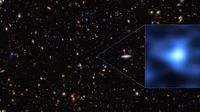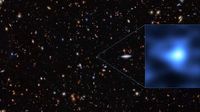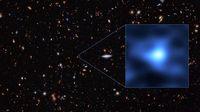In a groundbreaking discovery, astronomers have detected oxygen in the most distant known galaxy, JADES-GS-z14-0, pushing the boundaries of our understanding of early galaxy formation and maturation in the universe. This remarkable find was reported on March 20, 2025, by two independent research teams using the Atacama Large Millimeter/submillimeter Array (ALMA) located in Chile's high desert.
Originally discovered in 2024, JADES-GS-z14-0 is the most remote confirmed galaxy, with light that has traveled an astonishing 13.4 billion years to reach Earth. This means we observe it as it was when the universe was less than 300 million years old—only about 2% of its present age. The implications of this finding are significant; it suggests that complex chemical processes were already underway in the universe’s infancy, challenging conventional astronomical theories.
“It is like finding an adolescent where you would only expect babies,” explains Sander Schouws, a PhD candidate at Leiden Observatory and lead author of one of the studies now being published in The Astrophysical Journal. Schouws notes that this galaxy has formed and matured at an unexpected rate, contributing to a growing body of evidence that suggests the formation of galaxies happens much faster than previously thought.
Historically, astronomers theorized that the universe was too young to produce galaxies rich in heavy elements like oxygen at such an early stage. These elements are generally created within stars and disseminated throughout their host galaxies after those stars undergo supernova explosions. The newfound presence of oxygen in JADES-GS-z14-0—approximately ten times more heavy elements than previously anticipated—raises critical questions about the timeline and mechanisms of galaxy formation.
Stefano Carniani from Scuola Normale Superiore in Pisa, who led the second research team, expressed his surprise at the unexpected finds. “I was astonished by the unexpected results because they opened a new view on the first phases of galaxy evolution,” Carniani stated, reinforcing the idea that our understanding of cosmic history is still evolving.
The precision of ALMA's measurements further enhances the significance of this discovery. The observatory was not only able to confirm the presence of oxygen but also pinpointed the galaxy’s distance with a remarkable accuracy of just 0.005 percent. Eleonora Parlanti, a PhD student also from Scuola Normale Superiore, emphasized this precision: “This level of accuracy—analogous to being correct within 5 cm over a distance of 1 km—helps refine our understanding of distant galaxy properties.”
While the James Webb Space Telescope (JWST) initially identified JADES-GS-z14-0, it was ALMA’s capabilities that confirmed its distance and the presence of oxygen. Rychard Bouwens, an associate professor at Leiden Observatory, highlighted the synergy between these two astronomical giants: “While the galaxy was originally discovered with the James Webb Space Telescope, it took ALMA to confirm and precisely determine its enormous distance. This illustrates the amazing synergy between ALMA and JWST to reveal the formation and evolution of the first galaxies.”
The broader astronomical community is taking notice of these findings, prompting significant reappraisal of established galaxy formation models. Gergö Popping, an astronomer at the European Southern Observatory’s ALMA Regional Centre, shared his astonishment, stating, “I was really surprised by this clear detection of oxygen in JADES-GS-z14-0. It suggests galaxies can form more rapidly after the Big Bang than had previously been thought.”
This new evidence not only pushes the limits of astronomical theory but also invites more curiosity—what else lies hidden in the universe's early chapters? As more advanced instruments are developed and current technologies like ALMA and JWST continue to probe the cosmos, astronomers eagerly anticipate further revelations that could alter our understanding of creation and evolution in the universe.
The detection of oxygen in JADES-GS-z14-0 marks the most distant confirmed observation of the element to date, portraying a galaxy that defies previous assumptions about the early universe. This discovery serves as a reminder that the cosmos still holds surprises, and our quest to decipher its ancient history is far from over.




